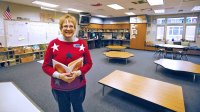Room to Learn: An Italian Makeover
Students get the chance to design the way they want to learn.
Your content has been saved!
Go to My Saved Content.When a dozen or so educators from Indianapolis traveled to Reggio Emilia, Italy, several years ago to study the famous constructivist approach in that city's preschools, they came back prepared for more than project-based teaching -- they came ready to decorate. Last fall, the group offered elementary school teachers a classroom makeover in the Reggio Emilia style, and Sharon Olson, a teacher at Winding Ridge Elementary School, immediately volunteered. Their decor strategy was based on the idea that to take ownership of their learning, children must own their learning space. So Olson and her Italian-influenced peers began by asking the third-grade students how they wanted their classroom to look. Her goal was to spark students' curiosity and creativity by turning the room into a garden for exploration. She wants the children to be observers, so her classroom is ever changing; almost every day, she moves an object or two from one place to another without telling them. The kids say,"I'm going to catch Mrs. Olson today."
Lower Class
"The kids asked to make more of our tables low to the ground. They're good for group work, and it's quieter because they can talk more closely to each other. They're especially good for kids with energy to sit on, so they're not falling off their chairs all the time."
DIY Decor
"I don't create anything on the walls. It's all theirs -- even the writing prompts. One girl drew these angles and decided that this would help everyone, so she posted it, and they all used it. I want the room to be a reflection of their work. It shows that this is their room, and, because of that, I think they're more involved with it. They're also proud of it because it's something they have put up instead of just something that I bought."
Counting Out
"I moved these jars out of the cabinets onto the shelves so they'd be visible, and now the kids use the items inside them for everything."
Word Smiths
"We created a reading center by displaying the books at the kids' level and talking with the students about how to organize them. We talked about how it would take forever to look through all the books to find your favorite -- you would use up all your reading time just looking for it."
Flashes of Inspiration
"I put various light filters in the window from time to time to change the light and draw the children's interest. When the sun shines through the crystal, it produces rainbows, which leads to questions about why that happens and what else can create that effect."
Face Time
"The students do self-portraits during their first few sessions in art class, and we post them on the wall for the whole year. The project lends itself to writing opportunities, in which kids discuss the feelings that come through in their portraits. It teaches the importance of details. It shows them that they are important enough to be pictured on the wall all year, that this is their classroom, not Mrs. Olson's classroom."
Pieces in Place
"I put the puzzles in the drawer so the kids don't have to take them apart when it's time to stop playing with them. Now they're more interested, because they know it's not over in twenty minutes, and they can get a sense of completion."
Brick-a-Brac
"When I put objects in the cinder blocks, the children ask questions -- ones they will find the answers to because I don't tell them. When we looked at this snow globe, it raised questions about what was going on inside. Is that water? Why is the snow glittery, not white? Everything in here creates an opportunity to inspire or write."
